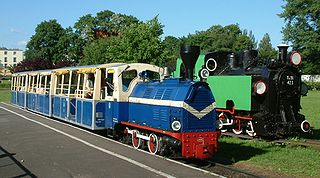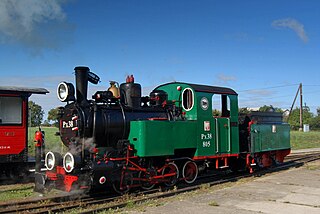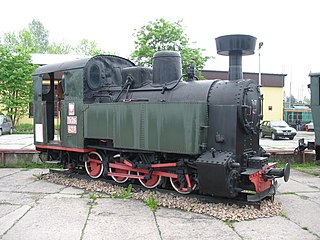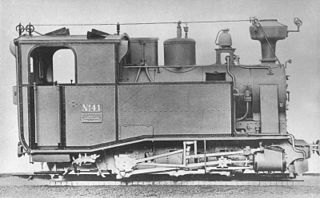
Tubize is a city and municipality of Wallonia located in the Belgian province of Walloon Brabant. On January 1, 2006 Tubize had a total population of 22,335. The total area is 32.66 km2 which gives a population density of 684 inhabitants per km2.

Orenstein & Koppel was a major German engineering company specialising in railway vehicles, escalators, and heavy equipment. It was founded on April 1, 1876, in Berlin by Benno Orenstein and Arthur Koppel.

Live steam is steam under pressure, obtained by heating water in a boiler. The steam may be used to operate stationary or moving equipment.

Narrow Gauge Railway Museum in Wenecja near Żnin (Poland) is an open-air museum collecting and exhibiting steam locomotives, passenger and freight cars, trolleys, railwaymen's tools, signalling equipment, contents of an old waiting room, old maps. The Narrow Gauge Railway Museum in Wenecja is a department of the Muzeum Ziemi Pałuckiej and was established in 1972 at a suggestion of enthusiasts of the Pałuki region, of which Żnin is considered the capital. The Museum has collected numerous steam locomotives. One of the oldest is the German one made by Orenstein & Koppel in Berlin in 1900. The Tx-1116 locomotive made by Henschel & Son and the Tx4-564 locomotive made by Hanomag are also very interesting. A real rarity is the Belgian locomotive No.2179 made by Les Ateliers Metallurgiques Nivelles with the unique wheel arrangement 4-6-2 ("Pacific"), and the only one which has steam brakes. There are also steam locomotives made in the First Polish Locomotive Plant in Chrzanów, including active Px38.

Decauville was a manufacturing company which was founded by Paul Decauville (1846–1922), a French pioneer in industrial railways. Decauville's major innovation was the use of ready-made sections of light, narrow gauge track fastened to steel sleepers; this track was portable and could be disassembled and transported very easily.

The Baldwin Class 10-12-D was a class of narrow gauge 4-6-0PT steam locomotives built by the Baldwin Locomotive Works (USA) for the British War Department Light Railways for service in France during World War I. They were built in 1916–1917 to 600 mm gauge.

The South African Railways Class NG G13 2-6-2+2-6-2 of 1927 was a narrow gauge articulated steam locomotive.

The South Australian Railways T class was a class of 4-8-0 steam locomotives operated by the South Australian Railways. Several were sold to the Tasmanian Government Railways; some others operated on the Commonwealth Railways.

Narrow Gauge Railway Museum in Sochaczew is a 750 mm -gauge heritage railway based at Sochaczew in Poland, about 50 kilometres (31 mi) west of Warsaw. The museum's headquarters are that of the former Sochaczew County Narrow Gauge Railway. It has a fleet of historic 750mm-gauge steam, diesel and electric locomotives, goods wagons, passenger cars and draisines. It has also a small number of standard gauge and other exhibits.
A few narrow-gauge railway lines were built in Denmark, the majority in 1,000 mm gauge. Most railway lines in Denmark were built with standard gauge from the beginning, since the country was fairly densely populated in the 19th century.

There are hundreds of kilometres of 600 mm, 750 mm, 785 mm, and 1,000 mm narrow-gauge lines in Poland. The metre-gauge lines are mostly found in the northwest part of the country in Pomerania, while 785 mm lines are found only in the Upper Silesia region. 750 mm is the most commonly used narrow gauge; it is used, for example, in the Rogów Narrow Gauge Railway and in Tarnowskie Góry with the world's oldest narrow-gauge railway in continuous service since 1853. Some narrow-gauge lines in Poland still operate as common carrier, while others survive as tourist attractions. One of the finest of the latter is the 600 mm narrow-gauge railway running from Żnin via Wenecja and famous Biskupin to Gąsawa in the Pałuki region. Railway traditions of Pałuki date back to July 1894 when the first two lines were opened.

The O&K CSÉT Shunting Locomotives were a class of nine small Irish steam locomotives built in Berlin, Germany, by Orenstein & Koppel for shunting wagons of sugar beet at the three Irish Sugar Company factories in Mallow, Thurles and Tuam. They were delivered in two batches, with the first six arriving in 1934 and the last three in 1935. The 1934 batch was paid for by barter, using cattle as payment. Each factory received three locomotives, and numbered them independently, leading to each factory having a No. 1, a No. 2 and a No. 3. Each factory applied their own design of number onto the tanks, and in some cases, bufferbeams, of their respective locomotives.

Px38-805, named Leon, is a preserved Polish 600 mm narrow gauge steam locomotive built by Fablok in Chrzanów, Poland. It was the only locomotive of PKP class Px38, and one of three built locomotives of Fablok W5A type.

The PKP class Lyd1 is a narrow gauge diesel locomotive class, covering two similar models built in Poland: WLs150 built by Fablok, and its development WLs180 (803D) manufactured by Zastal. It was used by Polish State Railways (PKP) on the narrow gauge railways in Poland, and on industrial railways.

The WLs75 is a small narrow gauge diesel locomotive built in Poland, at the ZNTK in Poznań. It was used mostly on industrial railways.

Px27 is a class of Polish State Railways (PKP) 600 mm narrow-gauge steam locomotive built by Fablok in Chrzanów, Poland, in 1929. Only two locomotives of this class were made, and one, Px27-775, is currently preserved.

Tx26-427 is a preserved Polish 600 mm narrow gauge steam locomotive built by Fablok in Chrzanów, Poland. It was the only locomotive of Fablok W2A type, included into PKP class Tx26 along with W1A type.

The Miniature Railway Company on Broadway in Manhattan, New York, operated their ridable miniature railways at four World Expositions around 1900 and delivered them to many parks throughout the world.

The Saxon I K (one-K) were a class of German narrow-gauge 0-6-0T locomotives of the Royal Saxon State Railways with a track gauge of 750 mm. In 1925, Deutsche Reichsbahn grouped these locomotives into their DRG class 99.750–752.

The WLs40 and WLs50 are narrow gauge diesel locomotives built in Poland, used mostly on industrial railways. A small number was used by Polish State Railways (PKP) as Ld1 class on narrow gauge railways in Poland.



















